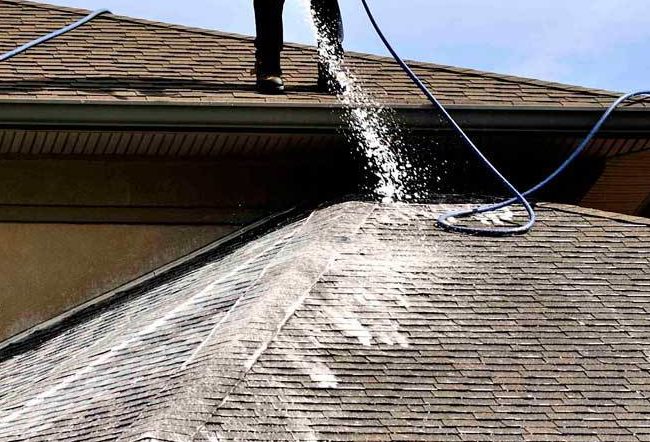Throughout our write-ups, we have touched on many roofing aspects. From roofing installation and roofing types to roofing maintenance, repair, and renovation, we have mentioned crucial areas that could lead to the successful erection and extended efficiency of roofs. However, roof cleaning isn't referenced as much. Something as simple and cost-effective as cleaning is usually neglected by both homeowners and roofing contractors alike. There is this typical behavior of overstating importance unto practices that seem more complicated or requires more financing. This reason is why homeowners and contractors barely make mention of roof cleaning. Be that as it may, cleaning your roof should be on par with roofing maintenance. In most cases, roof cleaning holds more importance than roof maintenance, mainly when carried out frequently. This article is meant to stress what roof cleaning is about, the required equipment and solutions used, and the vital benefits of this practice.
What Roof Cleaning Entails
Have you ever taken the time to give your roof a very long look after weeks of your last maintenance or renovation? You might not necessarily note defects or damages all the time. However, you are always bound to take note of something, which is dirt.
Dirt is more or less an encompassing term for things like mold, mildew and accumulated debris. It gets typically on the top of roofs during wet and windy seasons. This dirt usually poses no critical problems at first, but it can lead to a massive call for maintenance when left to grow. To curb such an occurrence, you should always engage in cleaning activities. As explained above, cleaning isn't considered an aspect of maintenance because of its less intrusive nature. On the flip side, it should be a vital aspect of maintenance because it reduces the severity of both climatic and biological attacks.
Cleaning Products and Equipment
Cleaning a roof, as highlighted above, isn't as demanding as roof repair or maintenance. However, there are still some equipment and cleaning solutions necessary to perform a fantastic cleaning job. These equipment and products are listed as thus;
- Chlorine Bleach: This solution is perfect for getting rid of mold and mildew. Chlorine bleach will completely disrupt the mold formation from its source and terminate any spores that will likely further the spread. It only requires diligent application on the concerned areas, which should be washed off with water after a few minutes.
- Emulsifiers: Emulsifiers are perfect for metal roofs because of their non-absorbent nature. This solution breaks down problematic debris and greasy stains on the roof and makes them very easy to wash off with water. Ammonia is the primary agent that helps in removing stains from shingles. You should apply generously to the affected area, but you should be careful not to abuse the solution.
- Tri-Sodium Phosphate: This cleaning agent is used together with water. The derived solution is then used to clean off mold and mildew from rooftops, with a brush used to scrub off the dirt. It would help if you were careful not to apply so much pressure while scrubbing not to cause any scratch or dent on your shingles. Then, use water to remove the dirt mixture. You can always perform this action again if you aren't pleased with the cleaning's initial outcome.
- Brushes: When talking of cleaning, brushes always come to mind. Granted, they are more of a secondary cleaning tool, but you can't deny their effectiveness in getting rid of dirt. Just a little back and forth action (pun intended) can go a very long way in weakening the dirt stuck on the roof even before any cleaning solution is used. As mentioned above, you should always be careful and apply less pressure when scrubbing with a brush. You should use brushes that don't have tough bristles to prevent shingle wear-off.
- Scrappers: Brushes can likewise be used on metal roofs, but they won't be as effective as scrappers. Scrappers are thin metallic instruments with a sharpened front-facing blade capable of cutting beneath sticky debris and dirt for quick and effortless removal. It is mostly used on metal roofs instead of asphalt shingles because metal roofs tend to have smoother and less curvy surfaces.
- Pressure Washer: Pressure water can seamlessly remove dirt from your roof at very high pressures. This pressure can cut through any sticky and thick substance without much stress. While it seems like a straightforward and viable option, it has often been labeled as a more destructive force on roofs than a beneficial one. It has been known to make shingles lose due to the pressure applied. You can carry our more research to determine if it's safe to clean with a pressure washer.
Benefits of Roof Cleaning
- Ice Dam Prevention: Cleaning your roof frequently can go a long way to prevent ice from forming at the edges of your roof during a snowy season. This ice can lead to icicle formations and blockage, making water run-off very difficult on the roofing structure.
- Algae, Moss, And Lichen Prevention: The presence of moss or algae on your roof can gradually reduce the lifespan of your roof. Constant and scheduled roof cleaning can stop this from happening and save you more expensive maintenance costs.
- Wood Rot Prevention: Moss and algae can create spaces under your shingles, which would let in moisture. This moisture could come in contact with the internal wood structure and cause it to rot. You can stop this from happening by preventing the further spread of algae and moss through thorough cleaning activities.
Cleanliness is next to Godliness. To get more ideas on roof cleaning and successfully carry it out, you can always count on Royal Roofing Queens. We are your number one choice for top-notch roof installation, repair, and maintenance. Reach out to us at 68-38 Main Street #2 Flushing, NY 11367 (718) 489-4009 https://www.kingsqueensroofing.com/ for your roofing projects and cost-free estimations.
